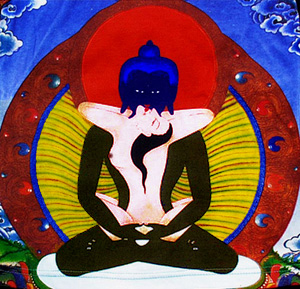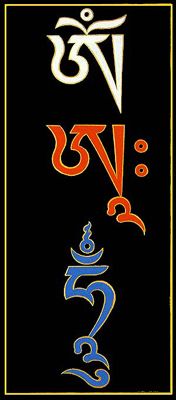

What is Deity Yoga?
 Certain individual sounds known as bijas, referred to as 'seed-syllables,' are thought to
contain the essence of a mantra and, by association, the essence of the deity. For example,
the Sanskrit letter "A" is considered to stand for the essence of the Prajnaparamita (Heart Sutra)
formula. (Left figure: Om Ah Hum)
Certain individual sounds known as bijas, referred to as 'seed-syllables,' are thought to
contain the essence of a mantra and, by association, the essence of the deity. For example,
the Sanskrit letter "A" is considered to stand for the essence of the Prajnaparamita (Heart Sutra)
formula. (Left figure: Om Ah Hum)
The most famous mantra, a bhija that also functions as a dharani is Om (AUM). The time and the universe are the manifestation of OM. Om is the past, present and the future, all that was, all that is, all that will be. Om was the sound of the act of Creation -- the creation of the universe ("In the beginning was the word" - John 1:1). For Tibetan Buddhists, it is the sound that embodies the source of all manifestations of enlightening activity; the Dharmakaya.
In the higher yoga tantras, the seed syllable plays an important role in the profound meditative process known as "taking the three kayas as a path," which is a technique to transform death, bardo and rebirth. Out of Space, we visualize the deity's seed syllable, the Samboghakaya (Enjoyment Body) understood as the mind of a Buddha, and this purifies the bardo state. The seed grows into the Nirmanakaya form of the deity, the actual manifestation which is understood to purify rebirth.
This ancient technique that uses the emergent and growing bija is a brilliant invention -- a multi-layered process in which the visual sign of a sound creates a kind of sensory synthesis. As it grows and transforms, we have an actual example of creation as in a "Word made Flesh" (John, New Testament). However, this ability is not to be thought of as the exclusive activity of omnipotent beings.
As we participate in this process of symbolizing symbols in which we draw out of Emptiness a name or label which then is made to grow into a form or object, in this case the actual form of a buddha, we are in immediate touch not only with the deity but with our own nature. We experience in an objective fashion, the basis and process by which all phenomena, including buddhas, arise.